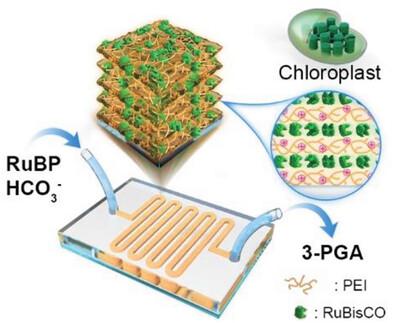Our official English website, www.x-mol.net, welcomes your
feedback! (Note: you will need to create a separate account there.)
Bio-Inspired Microreactors Continuously Synthesize Glucose Precursor from CO2 with an Energy Conversion Efficiency 3.3 Times of Rice
Advanced Science ( IF 14.3 ) Pub Date : 2023-12-03 , DOI: 10.1002/advs.202305629 Yujiao Zhu 1, 2, 3 , Fengjia Xie 1, 3 , Tommy Ching Kit Wun 4 , Kecheng Li 4 , Huan Lin 5 , Chi Chung Tsoi 1, 6 , Huaping Jia 1, 6 , Yao Chai 1, 6 , Qian Zhao 4 , Benedict Tsz-Woon Lo 4 , Shao-Yuan Leu 7 , Yanwei Jia 8 , Kangning Ren 2 , Xuming Zhang 1, 3, 6
Advanced Science ( IF 14.3 ) Pub Date : 2023-12-03 , DOI: 10.1002/advs.202305629 Yujiao Zhu 1, 2, 3 , Fengjia Xie 1, 3 , Tommy Ching Kit Wun 4 , Kecheng Li 4 , Huan Lin 5 , Chi Chung Tsoi 1, 6 , Huaping Jia 1, 6 , Yao Chai 1, 6 , Qian Zhao 4 , Benedict Tsz-Woon Lo 4 , Shao-Yuan Leu 7 , Yanwei Jia 8 , Kangning Ren 2 , Xuming Zhang 1, 3, 6
Affiliation

|
Excessive CO2 and food shortage are two grand challenges of human society. Directly converting CO2 into food materials can simultaneously alleviate both, like what green crops do in nature. Nevertheless, natural photosynthesis has a limited energy efficiency due to low activity and specificity of key enzyme D-ribulose-1,5-bisphosphate carboxylase/oxygenase (RuBisCO). To enhance the efficiency, many prior studies focused on engineering the enzymes, but this study chooses to learn from the nature to design more efficient reactors. This work is original in mimicking the stacked structure of thylakoids in chloroplasts to immobilize RuBisCO in a microreactor using the layer-by-layer strategy, obtaining the continuous conversion of CO2 into glucose precursor at 1.9 nmol min−1 with enhanced activity (1.5 times), stability (≈8 times), and reusability (96% after 10 reuses) relative to the free RuBisCO. The microreactors are further scaled out from one to six in parallel and achieve the production at 15.8 nmol min−1 with an energy conversion efficiency of 3.3 times of rice, showing better performance of this artificial synthesis than NPS in terms of energy conversion efficiency. The exploration of the potential of mass production would benefit both food supply and carbon neutralization.
中文翻译:

仿生微反应器利用二氧化碳连续合成葡萄糖前体,能量转换效率是水稻的3.3倍
CO 2过量和粮食短缺是人类社会面临的两大挑战。直接将CO 2转化为食品原料可以同时缓解这两个问题,就像绿色作物在自然界中所做的那样。然而,由于关键酶 D-核酮糖-1,5-二磷酸羧化酶/加氧酶 (RuBisCO) 的活性和特异性较低,自然光合作用的能量效率有限。为了提高效率,许多先前的研究都集中在对酶进行改造,但本研究选择向大自然学习,设计更高效的反应器。该工作原创性地模仿叶绿体中类囊体的堆叠结构,采用逐层策略将RuBisCO固定在微反应器中,以1.9 nmol min -1连续将CO 2转化为葡萄糖前体,活性增强(1.5倍) )、稳定性(约 8 倍)和可重复使用性(10 次重复使用后为 96%),相对于免费的 RuBisCO。微反应器进一步从1个并联扩大到6个,实现了15.8 nmol min -1的产量,能量转换效率是水稻的3.3倍,在能量转换效率方面显示出这种人工合成比NPS更好的性能。探索大规模生产的潜力将有利于粮食供应和碳中和。
更新日期:2023-12-03
中文翻译:

仿生微反应器利用二氧化碳连续合成葡萄糖前体,能量转换效率是水稻的3.3倍
CO 2过量和粮食短缺是人类社会面临的两大挑战。直接将CO 2转化为食品原料可以同时缓解这两个问题,就像绿色作物在自然界中所做的那样。然而,由于关键酶 D-核酮糖-1,5-二磷酸羧化酶/加氧酶 (RuBisCO) 的活性和特异性较低,自然光合作用的能量效率有限。为了提高效率,许多先前的研究都集中在对酶进行改造,但本研究选择向大自然学习,设计更高效的反应器。该工作原创性地模仿叶绿体中类囊体的堆叠结构,采用逐层策略将RuBisCO固定在微反应器中,以1.9 nmol min -1连续将CO 2转化为葡萄糖前体,活性增强(1.5倍) )、稳定性(约 8 倍)和可重复使用性(10 次重复使用后为 96%),相对于免费的 RuBisCO。微反应器进一步从1个并联扩大到6个,实现了15.8 nmol min -1的产量,能量转换效率是水稻的3.3倍,在能量转换效率方面显示出这种人工合成比NPS更好的性能。探索大规模生产的潜力将有利于粮食供应和碳中和。


















































 京公网安备 11010802027423号
京公网安备 11010802027423号